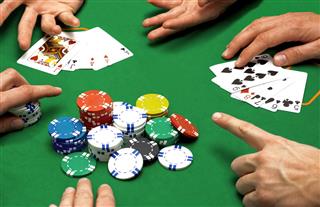
Rummy is a game wherein a player forms melds of certain matching cards of the same rank or suit. However, a lot of variations to this game exist, one of which is the Progressive Rummy. Plentifun explains the rules to play this Rummy type. Check it out!
Why Progressive You May Ask
This type of Rummy is called Progressive Rummy because the players progress from one round of the game to the next. With each new round, an additional card is dealt to compliment the respective meld. For instance, in the first round, 6 cards are dealt; a player must form 2 sets (3 cards each), which sum up to a total of 6 cards.
As in regular Rummy, the basic concept in this version stays the same; however, the sequences/melds to be made are predetermined for each round. A total of 7 rounds exist, each of which requires players to make certain melds by drawing and discarding. The player to complete the said sequence and laying off all cards first wins the round and scores a zero. The other players compute the score of the remaining cards in their hands.
The ultimate goal in the game is to accumulate as less points as possible. In strategy card games like Rummy, it’s very essential to understand and grasp the game rules beforehand; if you’re perfect with the rules, you could play Progressive Rummy like a pro.
Given below are the detailed rules and guidelines to play the Progressive Rummy card game. Take a look!
How to Play Progressive Rummy
What You Will Need
The game requires two decks of cards and one joker for two players. In case, more players wish to join, add one deck plus a joker per two additional players.
Prerequisites
The basic object of the game is to form melds or card combinations on every new deal, which are previously determined. The player to successfully form the expected meld and lay off all of his/her cards first, wins the respective round. At the end of the game’s seven rounds, the player with the least cumulative score wins the game.
There are two types of melds in Progressive Rummy: ‘Sets’, and ‘Runs’.
A set (abbreviated as ‘S’) is a combination of three or more cards of the same rank irrespective of the suit.
For example, 5 ♥ – 5 ♠ – 5 ♦.
A run (abbreviated as ‘R’) on the other hand is a sequence of four or more consecutive cards, which should necessarily belong to the same suit.
For example, 4 ♣ – 5 ♣ – 6 ♣ – 7 ♣ .
In case of a run, aces should either be considered high or low in rank, but not both.
For instance, the correct combinations are:
A ♣ – 2 ♣ – 3 ♣ – 4 ♣ (when the ace is considered low) or
J ♠ – K ♠ – Q ♠ – A ♠ (when the ace is considered high)
Whereas, Q ♣ – K ♣- A ♣- 2 ♣ isn’t right.
The following table illustrates the seven melds, and number of cards to be dealt per round. Memorize it to make the gameplay easier.
| Rounds | 1 | 2 | 3 | 4 | 5 | 6 | 7 |
| Cards Dealt | 6 | 7 | 8 | 9 | 10 | 11 | 12 |
| Melds | 2 S | 1 S and 1 R | 2 R | 3 S | 2 S and 1 R | 1 S and 2 R | 3 R |
Beginning Play
- Mix the two decks of cards, and deal each player 6 cards to begin the first round.
- Place the rest of the deck in the center and flip the top card; the deck would be used as the draw pile, and the flipped card would begin a discard pile.
- The player to the left of the dealer starts by picking up a card from either the draw or discard pile. He/she would then try to use it in his/her sequence, and discard a less useful card from his/her hand.
- The game continues in a similar fashion, wherein players draw and discard in an attempt to complete the said melds. Once a player is successful in forming a meld, he/she would lay it down on the table, and would ultimately win the round.
- Sometimes, confusion would arise when a player draws a card from the draw pile, and finds it useful to complete his/her meld. In such a case, there could be two possibilities: (i) the player by using the drawn card would lay off the formed meld, or; (ii) he would stick to the discard-one-card rule. In case of the latter, the player wouldn’t be able to complete the meld in that particular turn and will have to wait till he obtains another suitable card.
- In case a player is left with additional cards after laying off the meld of the respective round, he/she can lay off these cards by linking them to an existing meld, but only on his/her next turn. The round ends when a player is successful in getting rid of all of his/her cards.
- A Joker (could be more than one) is used as a wild card, and have the ability to replace any missing card in a particular sequence. If you get one, use it wisely.
- At the end of each round, players keep a score of the cards that remain in their hand. The score sheet for the same is given below.
Progressive Rummy Score Sheet
| Cards | 2 | 3 | 4 | 5 | 6 | 7 | 8 | 9 | 10 | J | Q | K | A | Joker |
| Points | 2 | 3 | 4 | 5 | 6 | 7 | 8 | 9 | 10 | 10 | 10 | 10 | 15 | 25 |
Overall, the game is pretty simple once you understand the rules correctly. Alternately, you could note down the seven melds for reference while playing Progressive Rummy. Play the game with your friends and family, and enjoy!


























